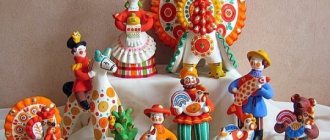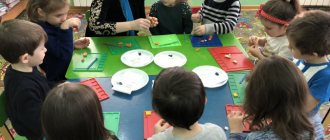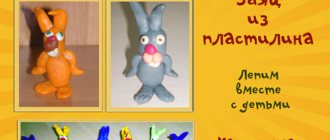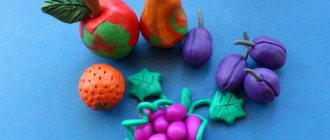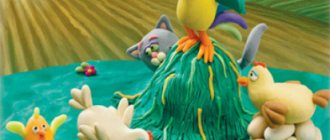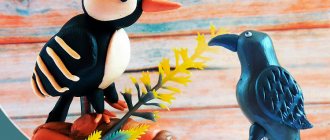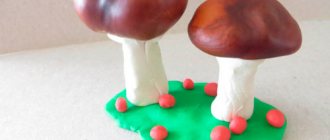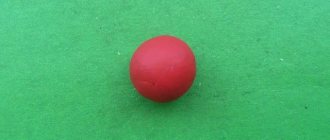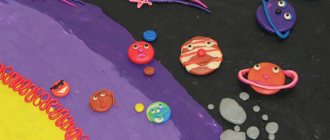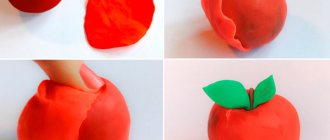How to mold a human head from plasticine. Master Class
Modeling a human head from plasticine tells children 5-6 years old the body proportions.
By taking your child through a step-by-step master class on sculpting a man’s head, you can develop the child’s ability to detail, since the head has many details. If something didn’t work out the first time, plasticine makes it possible to correct all the shortcomings.
Step by step sculpting:
- A ball is rolled out of beige or pale pink plasticine, which is given the shape of a human head and an oval face with a chin and forehead is formed. This is done using techniques of pressing and pulling with the fingers in the right places.
- From the side of the face, symmetrical recesses for the eyes are made with the flat side of a plastic knife.
- A small piece of plasticine is attached to the center of the face, from which the nose is formed. It should start from the bridge of the nose, gradually increasing the tubercle. The junctions between the nose and the face must be smoothed, then the nostrils should be made with a toothpick.
- Next, using a stack of pink plasticine, the lips are drawn.
- The oval whites of the eyes are attached to the eye sockets.
- Blue circles with black pupil dots are molded onto the eyeballs.
- Thin sausages are used to attach the upper and lower eyelids.
- Small oval ears are added to the head.
- Brown eyebrows are applied.
- A set of slightly flattened brown sausages is used to make a hairstyle that covers the crown, temples and back of the head.
- To sculpt an older person, you need to add wrinkles to the face using a stack, and make the hair gray with small strokes of white plasticine.
Modeling is one of the types of fine art. It plays an important role in the process of raising and educating preschool children. With its help, the child learns to give shape to an object, conveying its characteristic and most pronounced features. Modeling from plasticine or clay is one of the compulsory activities in kindergarten.
Creating even the simplest figure from clay or plasticine is a creative process that develops children's imagination.
So, for example, a small clay ball appears to a child as an apple, a ball or an orange, and a closed clay sausage can be a ring, a hoop or a donut.
During classes, the child learns to create an object, based on his existing ideas about shape and size. Trying to realize his plan, he often focuses on minor details, omitting the main thing.
One of the tasks of modeling is to teach the little man to set priorities correctly - to sort details according to their degree of importance.
Thus, sculpting:
- introduces the structure and proportions of all kinds of objects;
- promotes the development of fine motor skills, as it requires precise movements of the fingers;
- develops observation skills;
— teaches you how to implement a plan by setting priorities correctly.
In kindergarten, acquaintance with modeling occurs at the age of three, when children well understand the teacher’s instructions, are able to distinguish the shape of basic geometric shapes and find similarities and differences between them.
Both materials, both plasticine and clay, are flexible and plastic; with their help, you can create an endless variety of three-dimensional shapes.
There are 5 stages in mastering sculpting skills:
1. Getting to know the material - you need to tell the child about the properties of clay and plasticine and show what can be made from them. Some children at first refuse to pick up the material because of its unattractive appearance, but the majority show genuine interest - they begin to crush it or smear it on the table surface, while getting considerable pleasure.
2. Sculpting techniques . Making sticks or sausages. The teacher demonstrates the procedure, and the children, in turn, try to repeat. In this way, they learn the basic skill required for sculpting - rolling out material and shaping it into a specific shape. It can be a ball, cube, pancake, sausage. At this stage, the child learns to work with both hands at the same time and coordinate his movements.
3. Having mastered rolling out sausages, you need to learn how to make rings out of them. The child, repeating the movements of the teacher, closes the ends and receives a circle, donut or ring.
4. Basic modeling skills have been successfully acquired, which means it’s time to move on to more complex shapes - pyramids and cones. Children learn to roll out material at a certain angle, holding their hands in a vertical position, and master the skills of rolling and flattening.
5. The final stage of teaching preschoolers is the creation of figures of people and animals. You can begin this stage when the child learns to control the force of pressure on the material. Please note that the form in children's work is simplified: the head of a person or animal is made in the form of a small ball, and the limbs are cylinders.
Thus, modeling classes are an integral part of the comprehensive development of a child. Perseverance, precise work of the fingers, an understanding of the shape and size of different objects - these qualities and skills acquired in modeling classes will be useful at school. That is why in kindergarten a lot of time should be devoted to studying this discipline.
Modeling in kindergarten is divided into subject, plot and decorative.
Object modeling appears first in kindergarten classes. Children learn to sculpt simple objects and items: animals, people, furniture, dishes. Along with mastering the skill of modeling, the baby learns something new about living and inanimate nature.
For example, by depicting animals and people, the child understands for himself what parts of the body they have. In addition, the child enriches his vocabulary and also learns general concepts: furniture, dishes, animals.
The plot modeling appears a little later. This is a rather complex type of visual activity, as it requires serious intellectual effort from the child. Firstly, you need to think through the plot, draw up an action plan (what details and figures need to be sculpted), arrange all the elements in the desired composition, and also maintain the proportions of the objects. Children model the plots of fairy tales and short stories, then learn to talk coherently about their plot depiction. This develops smooth, detailed speech and creative abilities.
Decorative modeling is associated with completing tasks for the manufacture and decoration of various objects. It shapes the child’s aesthetic taste, creative abilities, and introduces folk crafts. Since there are many small details in decorative modeling (in ornaments, patterns), it actively develops subtle and precise movements of the baby’s fingers. This stimulates the speech centers of the brain and prepares the hand for writing. Children sculpt and decorate dishes, make souvenirs and decorations.
MAGAZINE Preschooler.RF
“Magic Modeling” program for the senior groupGoal: Development of creative abilities in children of senior preschool age.
Objectives of the circle: introduce children to unconventional modeling techniques, coloring finished products; consolidation of knowledge about Dymkovo, Khokhloma, Gzhel paintings; fix relief, volumetric modeling; introduce the technique of making salt dough products; to develop an interest in performing creative works using different materials and methods; consolidate children's knowledge of materials that can be worked with and be able to use them correctly.
Explanatory note:
Our time requires creative, non-standard people who think and act for the benefit of the development of the individual and society. Therefore, the social order of society is to develop children’s creative abilities, the ability to think outside the box, not to be afraid to express opinions that differ from the generally accepted, to see the unusual in the ordinary.
According to psychologists and teachers, preschool age is the most favorable for the development of thinking and imagination - a mental process that forms the basis of creative activity. Therefore, the development of creativity is one of the main tasks of preschool education and upbringing.
The use of non-traditional modeling techniques in the practice of working with children works to solve several developmental problems at once:
- development of children's creative abilities (in all the diversity of this concept);
- development and improvement of fine finger motor skills;
- developing skills and abilities to work with various materials, devices and tools;
- acquaintance with new techniques and technologies;
- ability to apply them in practice.
Frequency of the circle: once a week for one academic year.
Duration of the circle: 25 minutes.
Expected student results:
Sculpts objects of various shapes using learned techniques and methods of sculpting;
Creates small plot compositions, conveying proportions, poses and movements of figures.
Creates images based on folk toys.
September:
1. Topic: “Apples and pears.” Gifts of autumn. Signs of autumn.
Goals and objectives: Practice rolling a ball, oval, flattening, using natural material to complement the craft.
Materials and equipment: Salt dough, dummies of fruits, stacks,
reproduction of paintings with fruits. (1/59)
2. Theme: “Sunflower”
Goals and objectives: Practice rolling a ball, oval, flattening, using natural material to complement the craft.
Materials and equipment: Salt dough, photo of a sunflower, stack, seeds. (11/14)
3. Theme: Decorative plate “Rose”. Gifts of autumn.
Goals and objectives: To develop the ability to sculpt a rose from individual parts, roll out balls, flatten, and make a flower of 6-8 petals. Develop finger flexibility and learn to see the end result.
Materials and equipment: Clay, stack (11/20, 3/61)
4. Topic: Painting the decorative plate “Roses” in the Gzhel style
Goals and objectives: To introduce children to folk art. Continue to develop the ability to paint products after drying, select paints, mix, to obtain the desired shade. Place the work on a plate.
Materials and equipment: Gouache, brushes, palette, dishes with Gzhel painting (8/85)
October:
1. Topic: “Prickly hedgehog.” Animal behavior in autumn.
Goals and objectives: Separately sculpt needles in the shape of a cone, connect the parts. Supplement the work with fungi and apples.
Materials and equipment: Colored salt dough, stack, slide with a picture of a hedgehog in the forest in autumn (11/12)
2. Topic: “The horse is beautiful, daring”
Goals and objectives: Continue to introduce children to folk art. Model a horse from a whole piece of clay. Develop finger flexibility and learn to see the end result.
Materials and equipment: Clay, stack, water, photo of the Filimonovsky horse (2/56)
3. Topic: “Kargopol goat”
Goals and objectives: Continue to introduce children to folk art. Model a horse from a whole piece of clay. Develop finger flexibility and learn to see the end result.
Materials and equipment: Clay, stack, water, photo of the Kargopol goat (1/112)
4. Theme: “Elephant”
Goals and objectives: Strengthen the ability to sculpt three-dimensional things and develop motor skills.
Materials and equipment: Plasticine, stack, photo of an elephant, sample of an elephant (5/14)
November:
1. Topic: “Ladybug” (on a leaf)
Goals and objectives: Learn to sculpt a ladybug from parts: head, body, using moldings, additional material for decoration. Use a leaf cutter. Be able to regulate the pressure when performing moldings.
Materials and equipment: Salt dough, leaf mold, toy, water, brush (12)
2. Topic: Coloring with “Ladybug” paints.
Goals and objectives: To develop skills of accuracy when coloring work. Be able to use unconventional drawing skills - with your finger, to draw dots. Exercise in ways of working with paints, designing work on a piece of paper.
Materials and equipment: Gouache, brush, glue (12)
3. Topic: “Panel with flowers” (sgraffito).
Goals and objectives: Familiarization with the technique of sgraffito - “scratched” on plasticine. plasticine,
Materials and equipment: cardboard, stack, painting with flowers
4. Topic: “Penguins on an ice floe.”
Goals and objectives: Continue to develop the ability to sculpt a figurine from a whole piece, using the techniques of rolling, stretching, flattening, cutting in stacks, conveying their characteristic features and proportions. Use foil when sculpting the body. Develop children's imagination and intelligence.
Materials and equipment: Salt dough, foil, foam. (11/8)
December:
1. Topic: Coloring with paints “Penguin on an Ice Floe”.
Goals and objectives: Continue to develop children’s ability to paint figures after drying, to combine them into a common composition. To develop children’s ability to accurately convey a conceived idea when coloring a product.
Materials and equipment: Gouache, brush, glue. (11/8)
2. Theme: “Christmas tree under the snow” (relief modeling)
Goals and objectives: Introducing children to a new modeling technique - plasticine stretching. Materials and equipment: plasticine, stack, card with Christmas tree (13)
3. Theme: “Snow Maiden”
Goals and objectives: To learn to reflect the impressions received while observing winter nature. Develop artistic and creative abilities.
Materials and equipment: Clay, model of the Snow Maiden (10/24)
4. Topic: Painting the Snow Maiden with Gzhel paintings.
Goals and objectives: Repeat the “Gzhel” painting with the children. Exercise in ways of working with paints, develop aesthetic perception and sense of color. Continue to develop the ability to see the end result of the planned work.
Materials and equipment: Gouache, brush, palette. Folk painting “Gzhel” (8/85)
January:
1. Theme: “Elegant Christmas tree”
Goals and objectives: To develop the ability in children to cut out a Christmas tree using a stencil, smooth out the edges with a brush moistened with water, and independently come up with decorations - balls, toys, beads. Develop finger flexibility. Use familiar sculpting techniques in a new creative situation.
Materials and equipment: Salt dough, “Christmas tree” stencil made of cardboard, stack, beads. (17)
2. Topic: Coloring with paints “Elegant Christmas tree”.
Goals and objectives: Continue to develop the ability to paint a Christmas tree with paints, develop skills of accuracy when doing work. Develop creative imagination and coherent speech when writing stories about the Christmas tree. When decorating the Christmas tree, use various additional materials
Materials and equipment: Gouache, brushes, glue, threads, beads, confetti. (17)
3. Topic: “Kargopol horse”
Goals and objectives: Continue to develop the ability to sculpt from a whole piece of clay.
Materials and equipment: clay, stack. (7/8)
4. Topic: “Decorating the Kargopol horse.”
Goals and objectives: To practice ways of working with paints, to develop aesthetic perception and a sense of color. Instill a love for animals and a desire to help them.
Materials and equipment: Gouache, brush, palette (7/8)
February:
1. Topic: “Bear-folk toy”
Goal: Continue to strengthen the ability to sculpt from a single piece. Introduce the traditions of potters.
Materials and equipment: plasticine, stack (9/10)
2. Topic: “Mug for Dad.”
Goals and objectives: To develop children’s ability to sculpt a mug, roll out plasticine in the form of a strip, a ball, press a depression in it, and pinch the edges. Sculpt the initial letter of the name for decoration. Develop fine motor skills and imagination in decorating a souvenir. Materials and equipment: Plasticine, stack (6/28)
3. Theme: “Hearts”
Goals and objectives: Consolidating the ability to sculpt objects or parts of them from dough, using the movement of the entire hand.
Materials and equipment: Colored salt dough, water
4. Topic: “Stork on the roof.”
February: Practice “painting over” a picture with plasticine. Cultivate an interest in creativity.
Materials and equipment: Plasticine, cardboard, cards with migratory birds, encyclopedia about birds (15)
March:
1. Topic: “Four-legged friend”
Goals and objectives: To develop the ability to use knowledge about the features of the appearance of animals in their work. Strengthen the skills and abilities acquired earlier (rolling, flattening, pulling, smoothing edges). Develop creative imagination and interest in work.
Materials and equipment: Stacks, plasticine, cardboard (10/28)
2. Topic: Signs of spring.”Flower meadow.”
Goals and objectives: Improving manual labor skills by modeling from colored dough.
Materials and equipment: Colored dough, stacks, water, slides with spring flowers (11/14)
3. Theme: “Basket with flowers”
Goals and objectives: Continue to develop children’s ability to roll out clay in an even layer, cut out a basket using a stencil, and scratch with a fork. Tie the flagella together for the handle and bottom. Sculpt familiar flowers and leaves. Develop imagination and the desire to give joy to others.
Materials and equipment: Clay, fork, basket stencil, stack. (11/14)
4. Topic: Coloring the basket and flowers.
Goals and objectives: To cultivate interest in creativity, collectivism, and aesthetic perceptions.
Materials and equipment: Gouache, brush. (11/14)
April:
1. Topic: “Amazing underwater world” (plasticineography)
Goals and objectives: Introduction to non-traditional drawing techniques (plasticine).
Materials and equipment: plasticine, stack (11/26)
2. Topic: “Rocket”.
Goals and objectives: To develop the ability to make a cone-shaped shape. Develop fine motor skills of the hands.
Materials and equipment: Salted dough, stack. Rocket photo (14)
3. Theme: Geometric man
Goals and objectives: Continue to develop children’s ability to paint crafts after drying, selecting the right colors. To develop the ability to accurately convey a conceived idea when coloring a product, to reveal the creative imagination of children in the process of work.
Materials and equipment: Clay, skewer, paints, brush (6/14)
4. Topic: “My dad is a fireman”
Goals and objectives: Continue to develop the ability to sculpt funny little people using the techniques of rolling balls, ovals, flattening, and pulling. Use matches and sticks to connect the parts. Develop the ability to work collectively.
Materials and equipment: Clay, matches, sticks, stacks (2/79)
May:
1. Topic: “St. George’s Ribbon.”
Goals and objectives: To develop the ability to roll out clay with a rolling pin and cut out shapes according to a template. Cultivate an interest in creativity.
Materials and equipment: Plasticine, template, stack
2. Theme: “Clover”
Goals and objectives: To consolidate the ability to roll balls of different sizes. Continue learning how to apply a relief pattern using a stack.
Materials and equipment: Plasticine, template, stack (3/38)
3. Topic: “Circus in Samara.”
Goals and objectives: Continue to develop the ability to notice and convey in modeling the characteristic features of an architectural structure.
Materials and equipment: Plasticine, stack, circus photo (16)
4. Topic: “Children on a walk.”
Goals and objectives: Continue to teach children how to convey movement in sculpting.
Materials and equipment: Plasticine, stack. (2/80)
Bibliography:
- Bondarenko T.M. “Complex classes in the senior group of kindergarten.” EC "Teacher", Voronezh, 2007
- Volchkova V.N., Stepanova N.V. “Lesson notes for the senior group of kindergarten”, Voronezh, 2008
- Davydova G.N. “Plasticineography. Floral motifs", M., 2009
- “From birth to school”, edited by N.E. Veraksy, T.S. Komarova, M.A. Vasilyeva M., Mozaika-synthesis, 2014.
- Petrova O. “Animals made of plasticine.” FST-PRESS KNIGA LLC, M., 2013
- Plomer A.L. “Making from clay” Kharkov, 2013
- Educational publication “Art for children. Kargopol toy. ed. "MOSAIKA-SYNTHESIS", M., 2008
- Utkin P.I. "Folk artistic crafts of Russia." M., 1984
- Educational publication “Art for children. We are making a folk toy.” ed. "MOSAIKA-SYNTHESIS", M., 2010
- Educational publication “Art for children. Khokhloma painting". ed. "MOSAIKA-SYNTHESIS", M., 2010
- Firsova A “Miracles from salt dough.” LLC "AIRIS-press", M., 2013
| Next > |
How to make animals from plasticine. Master Class
Modeling from plasticine for children 5-6 years old is no longer difficult, since most of the techniques have already been mastered. With the help of step-by-step instructions, a child of this age can easily sculpt a cute figurine of this tiger, consisting of simple parts.
The sequence for creating a tiger is as follows:
- 1/3 of a block of bright orange plasticine is cut off. Both resulting pieces are rolled into balls.
- The small ball will be the tiger's head. From the second ball, part of the plasticine is pulled out into an oblong body.
- Using a toothpick or match, connect the head and body together.
- From the second block of orange plasticine, 1/3 of the part from which the hind legs are made is also cut off. This part must be kneaded and divided into 2 equal pieces, which should be shaped like a cone. Form feet on the wide side of the cone.
- For the front paws, a piece of plasticine is rolled into a sausage, then cut into 2 parts. Paws with thickened feet are made from them.
- Stick the paws to the tiger's body.
- Roll up and stick to the body a long tail made of thin sausage.
- Make small round ears with indentations and attach them to the head.
- Use white cakes and a nose from pink plasticine to create an animal's face.
- The tiger's eyes are made from round cakes of white, green and black, stuck on top of each other. You can add highlights around the edges of the eye.
- Attach a white chest made from a strip of plasticine on which wool is drawn in a stack to the neck.
- White cakes are glued to the hind legs as pads and toes.
- Now you need to create black stripes. A very thin sausage is rolled out of black plasticine, short sections of which are stuck all over the tiger's body. Also, claws on the hind legs are made from them and glued into the indentations of the toe pads made by the stack.
- Using a stack, make cuts to mark the toes of the front paws. 15 Use a toothpick to make dots on the white part of the tiger cub’s face.
The plasticine tiger is ready.
How to make a dinosaur from plasticine. Master Class
Dinosaurs are unusual animals that lived in ancient times. During the modeling process, the child can be told facts about their life and varieties.
Step-by-step diagram for sculpting a dinosaur:
- Cut off a third of the green block of plasticine and roll it into a ball-shaped dinosaur head. Next, a triangular shape with soft corners is created from the ball.
- For the body you will need a whole block of green plasticine. It must be kneaded thoroughly, then given an oval shape, which should be transformed by stretching into an oblong drop.
- Using a toothpick, both parts are connected together.
- To make massive dinosaur paws, you need 4 green balls of the same size.
- Sausages are rolled out from the balls, then the legs are formed.
- The paws need to be connected to the body; to do this, their edges should be slightly flattened.
- Making a large collar for the dinosaur. To do this, roll out a cake from a piece of green plasticine.
- An arc-shaped strip is cut out of it in a stack, then a zigzag pattern is created along the edge with a jagged stack.
- The collar is glued to the top of the dinosaur's head and the scalloped edge folds back nicely.
- On the head near the collar we attach a pair of beige horns.
- A green horn is glued to the nose.
- Triangular green plates are attached along the back and tail.
- Now you need to make a two-color plate. To do this, roll a piece of brown plasticine into a sausage, which is then wrapped in a thin black cake.
- From the resulting part you need to form a rectangle and cut it into 7-8 strips.
- Stick them on the back of the dinosaur and press it into the body.
- Attach white eyes with black pupils to the head.
- Along the entire surface of the back of the ballpoint pen, the dinosaur skin is given relief.
- In a stack, stripes are drawn along the collar, the line of the mouth and the tips of the paws.
The dinosaur is ready.
